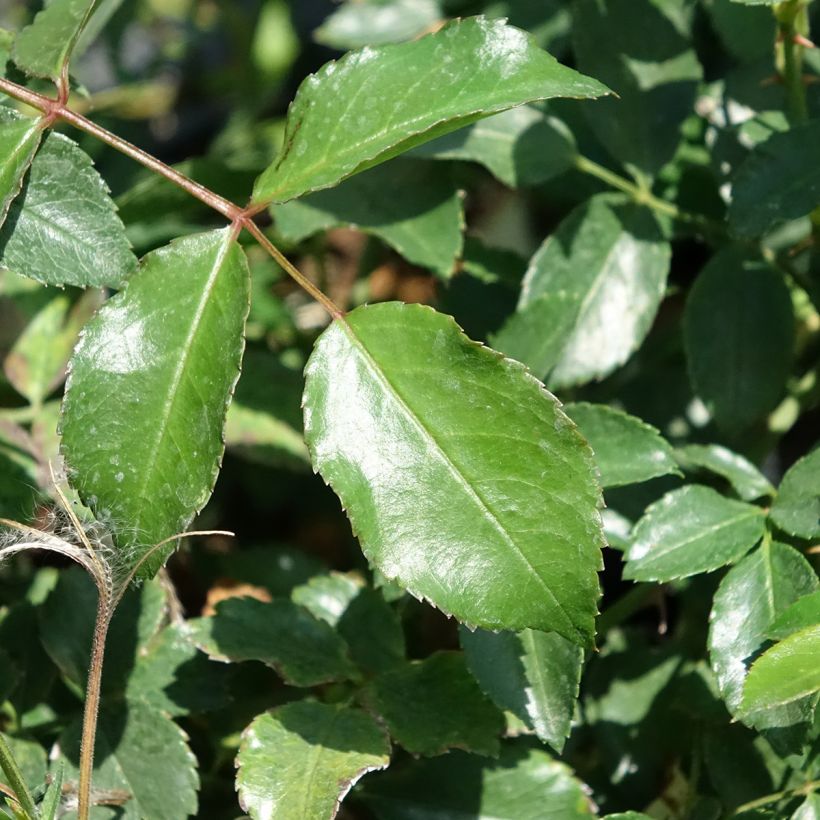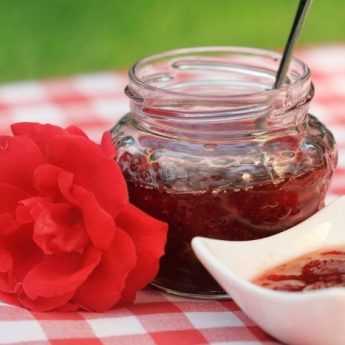

Rosa 'Meivahyn' ICE MEILLANDECOR® - Rosier Ice Meillandécor, Rosier Ice Meidiland
Rosa 'Meivahyn' ICE MEILLANDECOR® - Rosier Ice Meillandécor, Rosier Ice Meidiland
Rosa 'Meivahyn' ICE MEILLANDECOR®
Rosier Ice Meillandécor, Rosier Ice Meidiland
Home or relay delivery (depending on size and destination)
Schedule delivery date,
and select date in basket
This plant carries a 24 months recovery warranty
More information
We guarantee the quality of our plants for a full growing cycle, and will replace at our expense any plant that fails to recover under normal climatic and planting conditions.

Does this plant fit my garden?
Set up your Plantfit profile →
Description
The Ice Meillandecor® 'Meivahyn' Shrub Rose is a remarkable spreading rose variety prized for its ground-covering ability and abundant flowering. This wide, spreading bush reaches 60 to 80 cm in height and 100 to 150 cm in width, forming a dense, floral carpet that naturally spreads even over challenging garden surfaces. Its small white flowers with a delicate pink blush bloom continuously from late May until the first frosts. Particularly spectacular in June and autumn, its blooms take on slightly pinker hues as nights grow cooler. Its glossy, dense, and healthy green foliage highlights the brilliance of its flowers while being highly disease-resistant. Thanks to its abundant growth and ability to cover large areas, the Ice Meillandecor is an excellent choice for greening up a slope or populating a flower bed.
The Ice Meillandecor 'Meivahyn' Rose belongs to the Rosaceae family and stands out for its creeping and expansive habit, making it particularly suited to covering wide garden areas. At maturity, it achieves an impressive spread, quickly forming dense, balanced vegetation. Its flexible, vigorous stems arch slightly under the weight of the flowers, creating a natural, lush effect ideal for structuring a low-maintenance landscape design. Its delicate white with pink undertonesflowers appear in clusters throughout the season. Measuring around 5 cm in diameter, they consist of 21 finely arranged petals, revealing a centre of golden stamens that attract pollinating insects. Flowering begins in late May and renews continuously until the first frosts. The deciduous, glossy green foliage is dense and generously covers the stems, ensuring an effective ground cover. With its high disease resistance, especially black spot and powdery mildew, this rose maintains a healthy appearance all season without requiring any phytosanitary treatment. Adapted to harsh conditions, it tolerates moderate drought and poor soil, making it a top choice for stabilising slopes or greening up infertile areas.
Report an error about the product description
Rosa 'Meivahyn' ICE MEILLANDECOR® - Rosier Ice Meillandécor, Rosier Ice Meidiland in pictures


Plant habit
Flowering
Foliage
Botanical data
Rosa
'Meivahyn' ICE MEILLANDECOR®
Rosaceae
Rosier Ice Meillandécor, Rosier Ice Meidiland
Rosa Ice Meidiland
Cultivar or hybrid
Planting and care
The Ice Meillandecor groundcover roses prefer a sunny position (at least 4 hours of sunlight per day) but sheltered from the scorching midday rays and from strong winds. They thrive in loose, well-drained, humous-rich soil. They favour slightly acidic soil but will adapt to any garden as long as the ground is well-prepared and sufficiently fertile. To plant your rose in a pot, work the soil to a depth of 25 cm, breaking it up finely, and place a base fertiliser such as dried blood or dehydrated horn at the bottom of the planting hole. Position your plant after removing it from its pot, covering the top of the root ball with 3 cm of soil, backfill, and water thoroughly to eliminate any air pockets. During dry spells, water regularly for a few weeks to encourage root establishment. Also, consider feeding your rose with a special rose fertiliser to promote flowering.
Roses often develop spots or look unsightly by late summer, but this does not affect their growth. These marks are not harmful to the plant—it's a natural occurrence. Follow all our advice on how to address this issue and read our article: Help! My Roses Have Spots
Planting period
Intended location
Care
Planting & care advice
This item has not been reviewed yet - be the first to leave a review about it.
Haven't found what you were looking for?
Hardiness is the lowest winter temperature a plant can endure without suffering serious damage or even dying. However, hardiness is affected by location (a sheltered area, such as a patio), protection (winter cover) and soil type (hardiness is improved by well-drained soil).

Photo Sharing Terms & Conditions
In order to encourage gardeners to interact and share their experiences, Promesse de fleurs offers various media enabling content to be uploaded onto its Site - in particular via the ‘Photo sharing’ module.
The User agrees to refrain from:
- Posting any content that is illegal, prejudicial, insulting, racist, inciteful to hatred, revisionist, contrary to public decency, that infringes on privacy or on the privacy rights of third parties, in particular the publicity rights of persons and goods, intellectual property rights, or the right to privacy.
- Submitting content on behalf of a third party;
- Impersonate the identity of a third party and/or publish any personal information about a third party;
In general, the User undertakes to refrain from any unethical behaviour.
All Content (in particular text, comments, files, images, photos, videos, creative works, etc.), which may be subject to property or intellectual property rights, image or other private rights, shall remain the property of the User, subject to the limited rights granted by the terms of the licence granted by Promesse de fleurs as stated below. Users are at liberty to publish or not to publish such Content on the Site, notably via the ‘Photo Sharing’ facility, and accept that this Content shall be made public and freely accessible, notably on the Internet.
Users further acknowledge, undertake to have ,and guarantee that they hold all necessary rights and permissions to publish such material on the Site, in particular with regard to the legislation in force pertaining to any privacy, property, intellectual property, image, or contractual rights, or rights of any other nature. By publishing such Content on the Site, Users acknowledge accepting full liability as publishers of the Content within the meaning of the law, and grant Promesse de fleurs, free of charge, an inclusive, worldwide licence for the said Content for the entire duration of its publication, including all reproduction, representation, up/downloading, displaying, performing, transmission, and storage rights.
Users also grant permission for their name to be linked to the Content and accept that this link may not always be made available.
By engaging in posting material, Users consent to their Content becoming automatically accessible on the Internet, in particular on other sites and/or blogs and/or web pages of the Promesse de fleurs site, including in particular social pages and the Promesse de fleurs catalogue.
Users may secure the removal of entrusted content free of charge by issuing a simple request via our contact form.
The flowering period indicated on our website applies to countries and regions located in USDA zone 8 (France, the United Kingdom, Ireland, the Netherlands, etc.)
It will vary according to where you live:
- In zones 9 to 10 (Italy, Spain, Greece, etc.), flowering will occur about 2 to 4 weeks earlier.
- In zones 6 to 7 (Germany, Poland, Slovenia, and lower mountainous regions), flowering will be delayed by 2 to 3 weeks.
- In zone 5 (Central Europe, Scandinavia), blooming will be delayed by 3 to 5 weeks.
In temperate climates, pruning of spring-flowering shrubs (forsythia, spireas, etc.) should be done just after flowering.
Pruning of summer-flowering shrubs (Indian Lilac, Perovskia, etc.) can be done in winter or spring.
In cold regions as well as with frost-sensitive plants, avoid pruning too early when severe frosts may still occur.
The planting period indicated on our website applies to countries and regions located in USDA zone 8 (France, United Kingdom, Ireland, Netherlands).
It will vary according to where you live:
- In Mediterranean zones (Marseille, Madrid, Milan, etc.), autumn and winter are the best planting periods.
- In continental zones (Strasbourg, Munich, Vienna, etc.), delay planting by 2 to 3 weeks in spring and bring it forward by 2 to 4 weeks in autumn.
- In mountainous regions (the Alps, Pyrenees, Carpathians, etc.), it is best to plant in late spring (May-June) or late summer (August-September).
The harvesting period indicated on our website applies to countries and regions in USDA zone 8 (France, England, Ireland, the Netherlands).
In colder areas (Scandinavia, Poland, Austria...) fruit and vegetable harvests are likely to be delayed by 3-4 weeks.
In warmer areas (Italy, Spain, Greece, etc.), harvesting will probably take place earlier, depending on weather conditions.
The sowing periods indicated on our website apply to countries and regions within USDA Zone 8 (France, UK, Ireland, Netherlands).
In colder areas (Scandinavia, Poland, Austria...), delay any outdoor sowing by 3-4 weeks, or sow under glass.
In warmer climes (Italy, Spain, Greece, etc.), bring outdoor sowing forward by a few weeks.



































